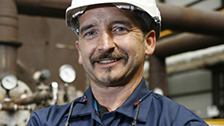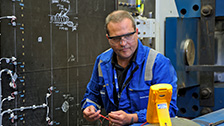We have decades of experience in the design, construction, and optimisation of wet scrubbers. To date, over 200 wet flue gas cleaning systems based on Doosan Lentjes technology have been installed in various plants around the world.
Wet scrubbers can be applied in sewage sludge incineration plants, in power stations as well as in industrial facilities and plants for the thermal treatment of waste. Due to the optimal utilisation of additives, wet scrubbers are used when operating costs for additives and the amount of residual material are to be kept low. If lime-based additives are used (e.g. limestone or hydrated lime), the valuable material gypsum can be produced instead of residual material to be landfilled. Furthermore, wet scrubbers can be used as the second stage of a flue gas cleaning system if the aim is to achieve particularly low emission values.
Depending on individual project requirements and goals, we offer acidic and alkaline systems. If the pollutant load in the wastewater needs to be separated, acidic and alkaline wet scrubbers are designed as separate cleaning stages. This is done either in a sequential design with separate scrubbing towers or in a combined scrubber design. The combined scrubber provides for integration of the acid scrubber into the alkaline one, with both systems separated by a separating floor. This design reduces both space and resource requirements and optimises investment and operating costs.
If the separation of the pollutant load is not necessary, the toxic substances (SOx, HCl, HF, ammonia (NH3) and mercury (Hg)) can in principle be separated in an alkaline system.
Acidic wet scrubbers
Our acid wet scrubber systems are primarily used to absorb the pollutant components hydrogen chloride (HCl), hydrogen fluoride (HF), ammonia (NH3) and mercury (Hg) from the flue gas. An acid scrubber is usually operated in combination with a separate alkaline SOx scrubber. More cost-efficient is the Doosan Lentjes option of integrating both scrubber stages in one scrubbing tower. Here, the flue gas enters the acid scrubber above the absorber sump. It flows upwards through the absorption zone in a counterflow procedure before entering the alkaline stage through a separating floor.
The flue gas quenching takes place in the acidic stage. The missing amount of liquid can be compensated by blowdown water from the alkaline stage. Since the scrubbing solution used contains recirculated absorbent, the acidic stage usually does not require additional sorbent if neutralisation of the effluent takes place externally.
To increase process efficiency, a fluidised bed generator – a so-called tray – is installed below the nozzle level. A fluidised bed forms on the tray as an additional absorption zone, which intensifies the contact between flue gas and wash suspension. Our patented technology with a variable tray allows the geometry to be adjusted during operation, thus ensuring optimum separation performance across all load ranges.
For additional separation of mercury (Hg), precipitant is dosed into the absorber sump, which chemically binds Hg.
Alkaline wet scrubbers
If the alkaline scrubber is preceded by an acidic treatment stage, it mainly absorbs sulphur dioxide (SO2) and sulphur trioxide (SO3) and partially absorbs the remaining pollutants. If your project does not require separation of the pollutant load in the wastewater, the alkaline wet scrubber can be used as a stand-alone solution to absorb all toxic substances contained in the flue gas (SO2, SO3, HCl, HF, ammonia (NH3) and mercury (Hg)).
The flue gas enters the alkaline scrubber from below. The absorbent is distributed in the flue gas via nozzle levels using the counterflow principle. Depending on the requirements and project conditions, limestone, milk of lime, caustic soda, or seawater, for example, can be used as a sorbent. If lime-based additive is used (e.g. limestone or hydrated lime), the valuable material gypsum can be produced instead of residual materials to be landfilled.
The washing solution used is recirculated by means of pumps in order to optimise the use of the absorbent. In the process, a reserve spray level with stand-by pump enables high plant availability.




